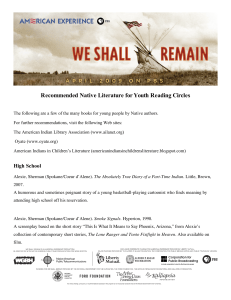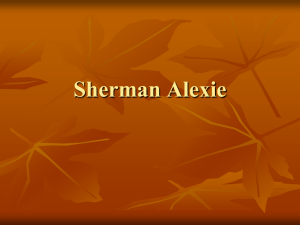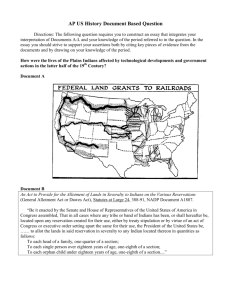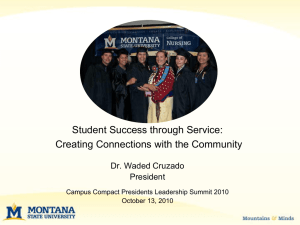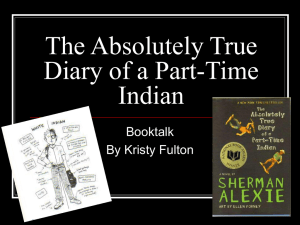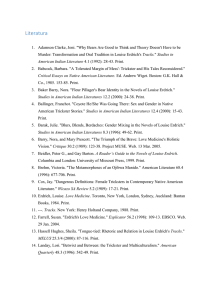Brochure Text - Kansas Humanities Council
advertisement
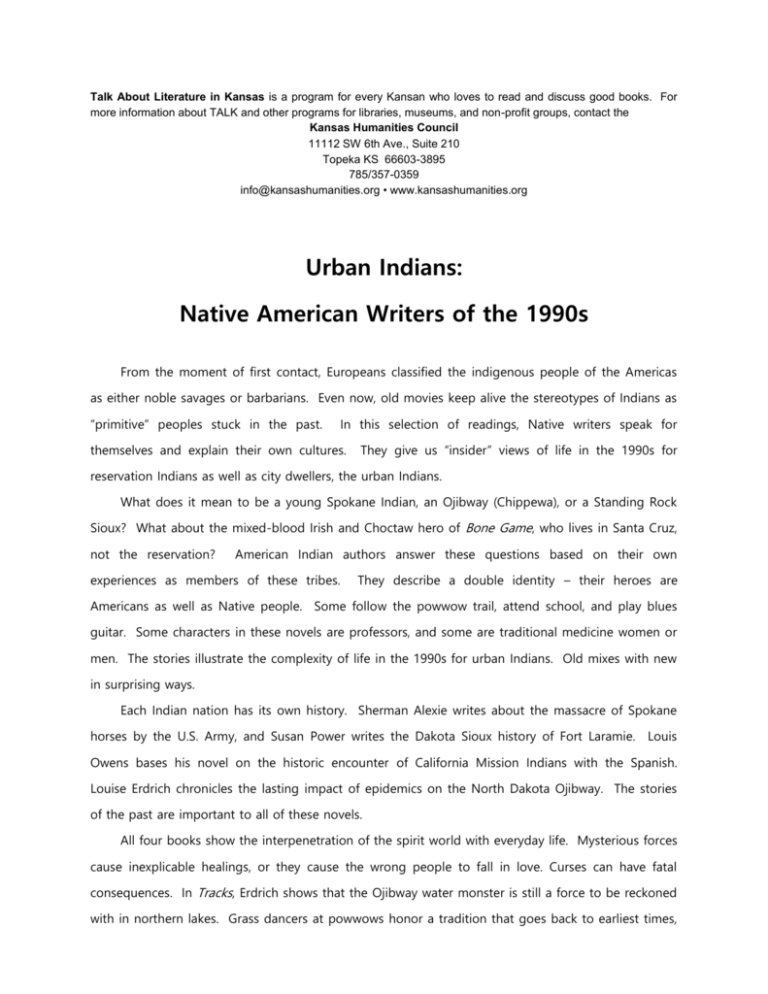
Talk About Literature in Kansas is a program for every Kansan who loves to read and discuss good books. For more information about TALK and other programs for libraries, museums, and non-profit groups, contact the Kansas Humanities Council 11112 SW 6th Ave., Suite 210 Topeka KS 66603-3895 785/357-0359 info@kansashumanities.org • www.kansashumanities.org Urban Indians: Native American Writers of the 1990s From the moment of first contact, Europeans classified the indigenous people of the Americas as either noble savages or barbarians. Even now, old movies keep alive the stereotypes of Indians as “primitive” peoples stuck in the past. In this selection of readings, Native writers speak for themselves and explain their own cultures. They give us “insider” views of life in the 1990s for reservation Indians as well as city dwellers, the urban Indians. What does it mean to be a young Spokane Indian, an Ojibway (Chippewa), or a Standing Rock Sioux? What about the mixed-blood Irish and Choctaw hero of Bone Game, who lives in Santa Cruz, not the reservation? American Indian authors answer these questions based on their own experiences as members of these tribes. They describe a double identity – their heroes are Americans as well as Native people. Some follow the powwow trail, attend school, and play blues guitar. Some characters in these novels are professors, and some are traditional medicine women or men. The stories illustrate the complexity of life in the 1990s for urban Indians. Old mixes with new in surprising ways. Each Indian nation has its own history. Sherman Alexie writes about the massacre of Spokane horses by the U.S. Army, and Susan Power writes the Dakota Sioux history of Fort Laramie. Louis Owens bases his novel on the historic encounter of California Mission Indians with the Spanish. Louise Erdrich chronicles the lasting impact of epidemics on the North Dakota Ojibway. The stories of the past are important to all of these novels. All four books show the interpenetration of the spirit world with everyday life. Mysterious forces cause inexplicable healings, or they cause the wrong people to fall in love. Curses can have fatal consequences. In Tracks, Erdrich shows that the Ojibway water monster is still a force to be reckoned with in northern lakes. Grass dancers at powwows honor a tradition that goes back to earliest times, 2 when returning warriors celebrated victory. They stir up more than memories when they dance in The Grass Dancer. These Indian writers show what is shared among all Indian tribes in the 1990s – a sense of humor and a vocabulary of words like “skin” for Indian and “apple” for assimilated Indian. Pop culture is present in the Indian world alongside ancient traditions. All together, these novels give readers a chance to visit four Native nations within the American nation, accompanied by writers who speak the language. These guides take the pen into their own hands and write the next chapter of American Indian history. Bone Game by Louis Owens Post-modern literature takes on new meaning in this novel that is a murder mystery, a history, a romance, and a good read. A mixed-blood professor has drifted from his Choctaw roots and lost interest in his teaching at the University of California. His dreams have become nightmares about a Mission Indian tortured by Spanish priests. He researches the history of Santa Cruz Mission, and by the time his estranged daughter comes to visit, he is deep into a mystery of murder and old curses. His Choctaw family comes to his rescue, as well as a memorable fellow professor, Alex, a Navajo cross-dresser. Nothing, not even gender, is what it appears to be in Bone Game. Owens, of Choctaw, Cherokee, and Irish heritage, teaches at the University of New Mexico. 243 pp. The Grass Dancer by Susan Power This first novel is a beautifully written account of northern Dakota Sioux characters caught in a web of the past and the present. Red Dress was the great-grandmother who lured soldiers to their death at Fort Laramie. A hundred years later her beauty and her powers are inherited by the reservation witch Mercury Thunder, and also by the good mother Lydia Wind Soldier. The healing of their children depends on the resolution of a painful love between the ancestor Red Dress and her husband, in the afterlife. Look for humor in the reservation dog named Chuck Norris and the Yuwipi man Herod Small War. Pumpkin, a red-haired Menominee powwow dancer from Chicago, is another memorable character, and her spirit haunts the book. Susan Power is a member of the Standing Rock Sioux tribe, a native of Chicago, and an attorney. 333 pp. Reservation Blues by Sherman Alexie 3 This is the first novel of talented Spokane poet Sherman Alexie, author of Fancy Dancer and The Lone Ranger and Tonto Fistfight in Heaven. He draws upon his upbringing on a reservation in eastern Washington state to color his story of an all-Indian rock-and-roll band. The band charms the hometown crowd with Indian-slang lyrics and takes to the road, along with roadies and groupies. By the time they reach the ultimate gig in New York – a recording session with Cavalry Records – they have achieved success in reservation bars and Seattle. In this road-trip novel, Alexie pokes fun at Indians and non-Indians alike. The patron saints of the novel are the resurrected bluesman Robert Johnson and Spokane healer Big Mom. Look for pop culture and Indian tradition mixed together in this tale by a foremost Generation-X writer. 306 pp. Tracks by Louise Erdrich Louise Erdrich’s Love Medicine won her a prestigious National Book Critics Circle Award and is the first of her four novels about the generations of an Ojibway family, the Kashpaws. Tracks, the third book in that series, traces backwards in time to 1912, when small pox and tuberculosis raged on the reservation. Nanapush, a survivor, narrates all the secrets of his generation to his step-daughter Lulu, in hopes she will understand her history and pass on the oral tradition of her people. Romantic love holds all of the characters together, from the prickly relationship of old man Nanapush and Margaret Kashpaw to the passion of Fleur Pillager and Eli Kashpaw. Fleur, however, is seduced by the water monster in Lake Matchimanito, and she belongs to no man. Of all of Erdrich’s books, this one explains the most about the Ojibway world of Catholicism and traditional spirit beings. 226 pp. Suggestions for Further Reading Alexie, Sherman. The Lone Ranger and Tonto Fistfight in Heaven . New York: Atlantic Monthly Press, 1993. ___. Indian Killer. New York: Atlantic Monthly Press, 1996. Bell, Betty Louise. Faces in the Moon. Norman: Oklahoma University Press, 1994. Erdrich, Louise. Bingo Palace. New York: Holt, 1993. ___. Love Medicine. New York: Holt, 1984. Harjo, Joy. In Mad Love and War. Middletown: Wesleyan, 1993. Hogan, Linda. Mean Spirit. New York: Ballantine, 1990. King, Thomas. Green Grass, Running Water. Boston: Houghton Mifflin, 1993. 4 Louis, Adrian. Skins. New York: Crown, 1995. Morris, Irvin. From the Glittering World: A Navajo Story. Norman: Oklahoma University Press, 1997. Owens, Louis. Other Destinies: Understanding the American Indian Novel. Norman: Oklahoma University Press, 1992. Silko, Leslie Marmon. Almanac of the Dead. New York: Simon & Schuster, 1991. Tapahonso, Luci. Blue Horses Rush In: Poems and Stories . Tucson: Arizona University Press, 1997. Welch, James. Indian Lawyer. New York: Norton, 1990.

